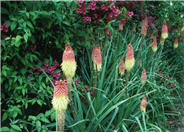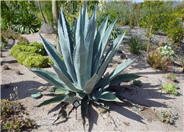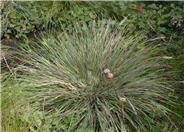
Common name:Torch Lily Improved
Botanical name:Kniphofia hybrids
This perennial will grow to about 6' tall and has large green, grass-like leaves with red, orange, and yellow tubular flowers that bloom in summer. Flowers resemble tiki torches. Hummingbirds love the flowers.

Common name:Yellow Margin Century Plant
Botanical name:Agave americana v. marginata
This form has a creamy yellow margin around the edge of the leaves and will grow 6-10' x 13' . It is a native to Mexico, and has a very open growth habit with leaves that recurve along their length. Susceptible to Agave Snout Weevil. Has stiff terminal spines and recurved teeth on margins. After blooming, which could take several years, it will die but will send up new pups from around the base.

Common name:Century Plant, Maguey
Botanical name:Agave americana
This plant is fast growing to about 6'-10' tall and 8'-13' wide. Wide gray leaves have stiff terminal spines and recurved teeth on margins. It prefers full sun and well-drained situations. After blooming, which could take several years, it will die but will send up new pups from around the base. Some people are allergic to the sap. Removal is difficult if unwanted.

Common name:Catmint
Botanical name:Nepeta X faassenii
Nepeta faassenii makes soft, grey-green, undulating mounds to 1.5' high in bloom, spreading 3'-4' wide. The small leaves are attractive to cats. This perennial has lavender blue flowers in summer. Catmint can be planted in sun or shade and needs medium amount of water. Prune spent flowers to encourage more blooms.

Common name:Olive, Edible Olive
Botanical name:Olea europaea
This broad tree will slowly grow to 20'-30' tall and wide. It has small, grey-green, evergreen leaves. Small white fragrant flowers bloom in spring, followed by fleshy black fruit that appears in fall. Fruit is messy and can stain sidewalks. There are cultivars that do not produce fruit. Some folks are allergic to the blooms. This tree is very long lived, with a beautiful gnarled trunk. It prefers full sun and low watering in summer months (twice a month) and none during the winter, when established.

Common name:Evergreen Eulalia
Botanical name:Miscanthus transmorrisonensis
This grass will reach about 3.5' high and has narrow, green leaves. Eulalia will arch and have an 8' wide spread. Golden flower spikes appear in spring, lasting through winter, shooting up 6' tall. Eulalia is drought tolerant once it's established but give occasional water to spruce it up. It prefers full to part sun. Give this grass some width area.

Common name:Goldenrain Tree, Varnish Tree
Botanical name:Koelreuteria paniculata
This tree reaches 30' tall and wide. Crown of tree is rounded. Blue green foliage is lacy and delicate looking, turning yellow in the fall. Upright yellow flower clusters bloom in the summer, followed by lantern shapeded seed pods. This dependable tree is attractive all year round, tolerating urban conditions and various soil types. It prefers full sun and occasional watering once it's established.

Common name:French Lavender, Toothed Lavender
Botanical name:Lavandula dentata
This lavender has green leaves and will grow 3' tall and 5' wide. It has lavender flowers that are prominent in the spring and summer months.

Common name:Santa Barbara Daisy, Mexican Daisy
Botanical name:Erigeron karvinskianus
This low mounding perennial, with fine leaves and white to pinkish, daisy-like flowers, is an excellent asset to rock gardens.

Common name:Mendocino Reed Grass
Botanical name:Calamagrostis foliosa
This tufted perennial bunchgrass is native to the Northern California coastal scrub. It forms a beautiful, dense mound of grey-green leaves that reach 2' tall, with showy arching buff colored flower stalks to 3' tall in spring and summer. Reed Grass foliage turn into an attractive purple coloration in the fall and winter. This evergreen should be grown under sun, with little or no summer watering required. -Monterey Bay Nursery
Designer: Mark Lewis
Photographer: GardenSoft
Maintain a two to four inch layer of mulch on the soil surface to reduce weeds, infiltrate rain water, and reduce compaction.
Mulching and adding compost to soil can minimize evaporation and help soil absorb and store water.
Develop healthy soil for plants that are vigorous and naturally pest-resistant.